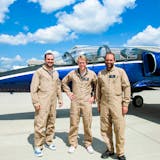One evening four years ago, Jacob Berk came to a realization watching old footage of military flights as he unwound from a shift waiting tables at Minneapolis' Rock Bottom Brewery.
He wanted to be a pilot.
"It dawned on me, this feeling of regret that I could have been doing something I loved and I wasn't and it hurt me," said Berk, who is 28. "I decided then and there to pursue the dream."
Today, with flight school done and nearly all of the required 1,500 hours of flying time built up, Berk's timing is turning out to be perfect. This year, U.S. airlines expect to hire 10,000 pilots.
A shortage of pilots is one of several constraints on airlines as demand returns to normal two years after the coronavirus pandemic brought air travel nearly to a halt. Ground agents and other workers are also in short supply. But the supply of pilots more directly affects airline operations because they perform the actual work of flying and can't be rapidly replaced.
For much of the 2010s, airlines, pilot groups and analysts debated pilot numbers. Even before the pandemic, air travel demand appeared to be outgrowing pilot staffing. And after it hit, airlines slashed schedules and staff, in part by encouraging pilots to retire early.
Delta Air Lines, the dominant carrier at Minneapolis-St. Paul International Airport, offered early retirement packages and lost 2,000 of its 14,000 pilots in 2020.
Delta's chief executive Ed Bastian said it lost more pilots to early retirement than any other airlines — and most of the 2,000 pilots were among its most seasoned veterans.


